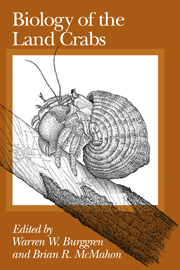Book contents
- Frontmatter
- Contents
- List of contributors
- Preface
- 1 BIOLOGY OF THE LAND CRABS: AN INTRODUCTION
- 2 EVOLUTION, SYSTEMATICS, AND GEOGRAPHICAL DISTRIBUTION
- 3 ECOLOGY
- 4 BEHAVIOR
- 5 REPRODUCTION AND DEVELOPMENT
- 6 GROWTH AND MOLTING
- 7 ION AND WATER BALANCE
- 8 RESPIRATION
- 9 CIRCULATION
- 10 ENERGETICS AND LOCOMOTION
- 11 EPILOGUE
- APPENDIX: Natural histories of selected terrestrial crabs
- References
- Author index
- Systematic index
- Subject index
7 - ION AND WATER BALANCE
Published online by Cambridge University Press: 04 August 2010
- Frontmatter
- Contents
- List of contributors
- Preface
- 1 BIOLOGY OF THE LAND CRABS: AN INTRODUCTION
- 2 EVOLUTION, SYSTEMATICS, AND GEOGRAPHICAL DISTRIBUTION
- 3 ECOLOGY
- 4 BEHAVIOR
- 5 REPRODUCTION AND DEVELOPMENT
- 6 GROWTH AND MOLTING
- 7 ION AND WATER BALANCE
- 8 RESPIRATION
- 9 CIRCULATION
- 10 ENERGETICS AND LOCOMOTION
- 11 EPILOGUE
- APPENDIX: Natural histories of selected terrestrial crabs
- References
- Author index
- Systematic index
- Subject index
Summary
Introduction
Species of aquatic crabs live in waters ranging in concentration from freshwater (0–15 mOsm.kg-1 H2O) to hypersaline media (>l, 000 mOsm-kg-1 H2O). These waters may be of relatively constant composition (offshore seawater and large lakes) or of fluctuating composition due to tidal or climatic factors. Crabs (and other aquatic organisms) have developed mechanisms to maintain the preferred concentrations of their tissue fluids in the particular medium in which they live. Several distinct patterns of osmotic and ionic regulation are evident (see reviews by Greenaway, 1979; Mantel and Farmer, 1983) and will be briefly summarized.
Species characteristic of sublittoral marine habitats have body fluids similar in concentration and composition to seawater. They are relatively permeable to water and ions and produce urine that is isosmotic with the hemolymph. Limited regulation of the ionic composition of the hemolymph is generally evident with magnesium and sulfate concentrations kept lower than in seawater by preferential elimination in the urine. Concentrations of the other major ions are often slightly higher in the hemolymph than in seawater. The animals may withstand limited dilution of their medium but show no ability to regulate the concentration of their extracellular fluids, which remain isosmotic with the medium. Crabs showing this pattern of osmoregulation are referred to as osmoconformers.
Many euryhaline crabs regulate the concentration of their hemolymph in dilute media. In seawater and concentrations higher than seawater, their extracellular fluids are isosmotic with the medium, but in media of lower concentration they attempt to maintain the osmolality of the hemolymph above that of the medium. This results both in loss of ions across the body surface down electrochemical gradients and in osmotic influx of water.
- Type
- Chapter
- Information
- Biology of the Land Crabs , pp. 211 - 248Publisher: Cambridge University PressPrint publication year: 1988
- 35
- Cited by



